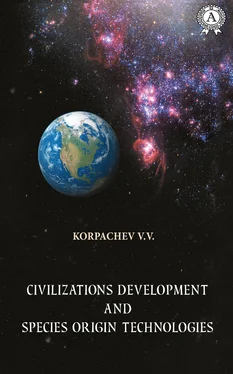1 ...8 9 10 12 13 14 ...19 The eye also cannot be simpler, since the absence of any part will lead to a disruption of its functioning. The creation of such a system should be planned and programmed by a highly developed intelligence. On this occasion, Isaac Newton, the great physicist, said the following: «Was the eye created without understanding optics, and the ear − without the knowledge of acoustics»?
In another example, having listed the bacterial flagellum numerous components, M. Behe demonstrated that such a system was too complicated to develop from a simpler predecessor, and Darwin’s evolution could not lead to the occurrence of such an uncomplicated complexity. The flagellum is designed specifically as a means of bacteria transportation and is composed of many interacting parts. In the absence of any of its components, functioning becomes impossible in case of any of its components’ absence.
M. Behe argues that the «irreducible complexity systems» existing in the body cannot be formed by means of the sequentially added elements, since the each element’s useful function is launched only when it is integrated into a complete system. But in such a case, organisms are the product of rational consciousness; that is, created in accordance to the plan. If the morphological evolution of animals can still be somehow imagined, then molecular one is difficult to imagine. The key point of M. Behe’s argumentation is that in no scientific source provides one with the detailed, testable scenarios of how incredibly complex biochemical systems could be formed under the influence of the evolutionary processes. In his opinion, the more complicated the system, the less its spontaneous occurrence likely.
M. Behe states that the alleged irreducible complexity could not be the result of an evolutionary process and therefore it can only be explained through the intelligent design. He does not deny microevolution based on Darwinian mechanisms that adapt the species to specific environmental conditions, but these mechanisms are not able to carry out structural changes in the body and generate the «inexcusable complexity» systems. As a result of the calculations, the scientist was able to establish extremely low values of the complex organic molecules’ spontaneous nucleation probability by means of calculations performed. Opponents of M. Behe believe that this value is explained by the extreme scarcity of information regarding the conditions under which chemical reactions can take place leading to the occurrence of such molecules. Therefore, this number cannot be considered as seriously justified one.
The irreducible complexity concept’s critics believe that in the course of evolution something which was just beneficial at first, may later, with the change of other parts, become necessary. Moreover, various parts of the system can spontaneously change, acquire other functions, or, having lost their functions, be removed from the system. For example, scaffolding supporting the «irreducible complex building» is necessary until the building can stand on its own. There are also the evidences provided that the bacterial flagellum has a precursor possessing proteins that are homologous to ones found in the bacterial flagellum. It should be noted that there should have been someone to create scaffolding and the flagellum predecessor. Nothing comes out of nowhere.
M. Behe’s doctrine opponents suggested that some parts could be temporarily borrowed from other organisms and simpler molecular systems. However, Scott Minik, who has been studying flagellar bacteria for 20 years, refuted this assumption having proved that 30 out of 40 parts that constitute the bacterial flagellum are unique and could not have been borrowed from any other system. Even if such parts had been found, borrowing would have been just a part of the problem, since its functioning requires not only specific details, but the exact assembly sequence as well.
Kenneth Miller, a biologist from Brown University, demonstrated a computer animation of the flagellum’s performance. He began to disassemble the «mechanism», removing dozens of parts from it, not one at a time. In the end, he removed a significant portion of the complex system, but the remaining parts continued functioning. It is believed that these data have refuted the main argument of M. Behe regarding the indivisible complexity. However, I have a question: can a computer animation, in which the movement of each flagellum part is programmed, correspond to the living organism’s functional characteristics?
Mark Perakh, a professor of Mathematics and Statistics of California State University, Fullerton, in his critical article «Intelligent Design or Blind Accident? «A clash of Two Worldviews» expressed the opinion that many biochemical systems described by M. Behe are characterized by excessive complexity. If so, it can be explained either by the result of the chaotic uncontrolled events’ sequence, or by the irrational design. In the absence of evidence that the complexity of the system is irredundant, this complexity is more likely to indicate a blind incident than the rational design. However, I believe that M. Perakh is also wrong in this aspect. It is not the excessive complexity that is observed, but the minimal complexity capable of the function’s provision.
Many biochemical systems described by M. Behe are not characterized by excessive complexity; they are the rational complexity necessary to perform certain complex functions. These difficulties are not excessive, but rational.
Rukhlenko I. A. (Рухленко Илья Александрович) (Dean of the faculty of ecology of Volzhsky University named after V. N. Tatishchev) in his two-volume book «What is the Answer to the Darwinist?» gives practical advice to people who have skepticism towards the modern theory of evolution, but are engaged in verbal disputes with sticklers for Darwinism. The author explains in detail that they should respond, if they refer to the following:
1) Palaeontological; 2) molecular genetic; 3) comparative anatomical; 4) embryological; 5) bio-geographical «evidences of evolution». Especially considered in detail the examples of observed evolution, based on the empirical void. They are unacceptably few and most of them are not examples of evolution. In addition to the of «evidences of evolution» criticism, the book covers a large number of facts related to different areas of biology that contradict the concept of natural evolution, and explains them by means of the Intelligent design’s different theories. The analysis of the advantages and disadvantages of the Intelligent design’s theory compared to the theory of natural evolution is provided. The conclusion is that it is the concept of continuous creation that successfully explains most of the biological facts today.
The «Intelligent Design» movement’s leading representatives, working for the «Discovery Institute» non-profitable public organization, consider it as a scientific theory, according to which certain features of the Universe and life are best explained by an intelligent first cause and could not occur as a result of natural processes without conscious control. Intelligent design argues that there are enough evidences in nature that life and nature are the result of a thoroughly thought-out design plan. Nature can be treated more as a result of preliminary planning, but not as a simple adaptation’s consequence.
Books dedicated to the Intelligent Design «The Signature in the Cell», «Darwin’s Doubt» (S. Meyer), «Undeniable» (D. Ax) and «Darwin on Trial» (Ph. E. Johnson) are published in significant circulations and are sold well. However, works dedicated to this problem are not accepted by the peer-reviewed journals and scientific conferences. The «Intelligent Design» concept does not find recognition as a scientific theory and is considered as pseudoscience in the vast majority of American scientific organizations.
Читать дальше












